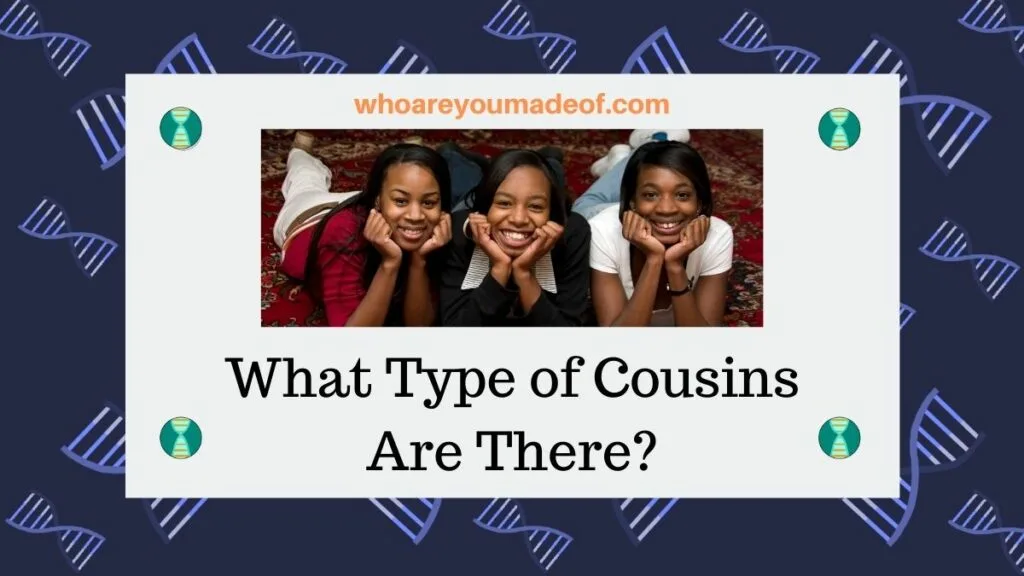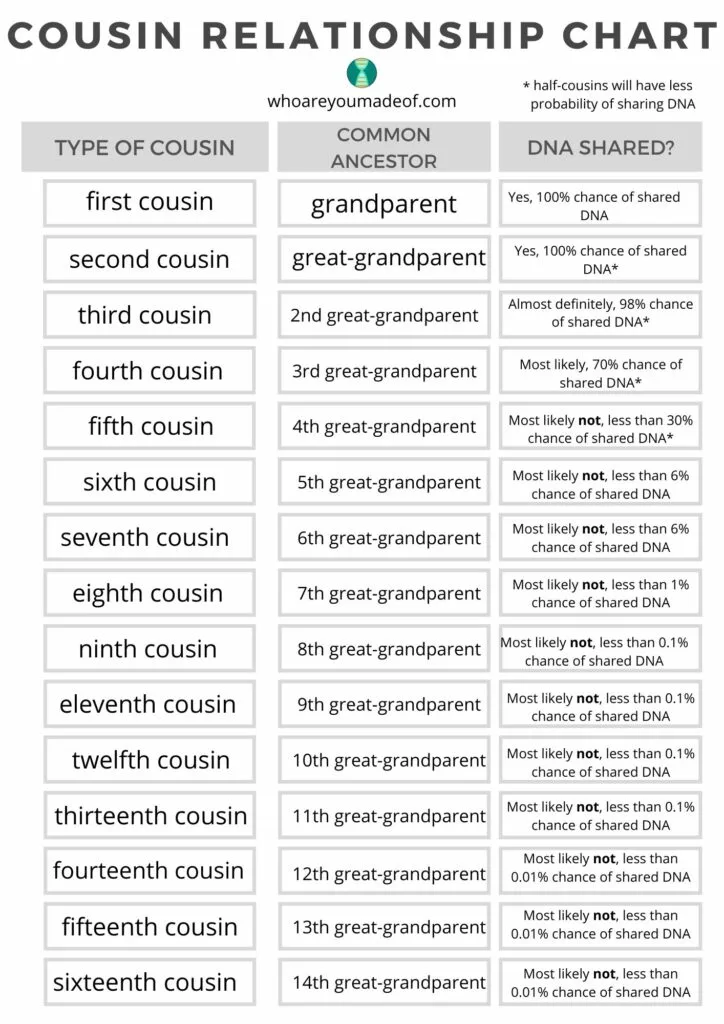Do you want to know what types of cousins there are? In this post, learn everything that you need to know about all kinds of cousins.
In this post, you will discover:
- The definition of a cousin
- The types of cousin in your family
- How to figure out what type of cousins you are
- How many total cousins a person has
- Whether you are genetically related to all of your cousins
- If cousins always look like each other

Before we jump into the conversation about what kinds of cousins we have, it is important to understand exactly what a cousin is. All of our cousins, no matter what type of cousin they are to us, have a specific type of relationship to us that is based on who the shared ancestor is to each of you.
What is a cousin, exactly?
A cousin is a person who shares a common ancestor with you, yet is descended from a different child of your common ancestor. Your cousin is descended from what is sometimes called a diverging or collateral line from the shared ancestor or ancestors.
Anyone who shares a common ancestor with you and is not a direct descendant of you or your siblings, a direct ancestor, or a sibling of a direct ancestor, is your cousin. Our direct ancestors are people like parents, grandparents, and great-grandparents, and beyond, as well as their siblings who are our aunts/uncles, great-aunts/uncles, and so on.
The most common example of a cousin is a first cousin, since they are the easiest to understand. You and your first cousins share a common ancestor (i.e. your grandparents), yet you are descended from different children of that ancestor.
What types of cousins are there?
Every person on earth has cousins who are related to them by varying degrees, ranging from first, third, and fifth cousins to twentieth cousins and beyond. There is technically no limit to the type, or degree of kinship, that we can use to describe a family relationship between two cousins.
Below are the most common "types" of cousins that we usually discuss in in genealogy research. The reason that we don't usually hear cousins more distant than ninth cousins mentioned is because, while we certainly do have them, cousins more distantly related are very distant, and quite numerous.
You will read more about how many cousins of each type the average person might have further on in this article.
I have written individual articles dedicated to each category of cousin, and so you can click on the type of cousin that you want to learn about to find out everything you need to know about cousins of that relationship distance.
- First cousins
- Second Cousins
- Third Cousins
- Fourth Cousins
- Fifth Cousins
- Sixth Cousins
- Seventh Cousins
- Eighth Cousins
- Ninth Cousins
If you have any specific questions relating to a particular type of cousin, I highly recommend visiting the linked article above. In each article, I answer questions such as how many cousins of that particular relationship a person might have, as well as details about shared DNA, who the common ancestor is - and much more.
Keep reading this article to learn more about cousins types in general.
Are we all cousins?
Since there is no limit to the types of cousins that there can be, the natural question is whether we are all cousins to each other. Technically, yes, we are all related to each other.
But what type of cousin relationship will most of us have with each other? There is a popular belief that we are all 16th cousins or closer, but this is an oversimplification of the idea.
The actual genealogical relationship, another way to say "cousin relationship", that two randomly selected people might have with each other will depend on several factors. Most importantly, we need to know whether the ancestors of those two people lived in the same part of the world within the past 500 years or so.
If they did, then there is a good chance that they are 16th cousins or closer. Otherwise, they could be even more distantly related.
How to calculate cousin relationship?
The easiest way to calculate your cousin relationship with a cousin the same number of generations removed from your shared ancestor is to determine your mutual relationship to that ancestor. Then, simply count the number of "greats", add one, and you have the "type" of cousins that you are.
For example, if you and your cousin share a great-grandfather, then the "number of greats" is one. Then, add one, which equals, of course, two.
This means you are second cousins.
If you share a great-great-great-great grandparent (i.e. 4 "greats"), you just +1 to arrive at 5, which means you are fifth cousins.
Or, you can use this cousin relationship calculator.
Here's a quick list to help you find how you are related to your cousin:
- first cousins share grandparents
- second cousins share great-grandparents
- third cousins share great-great grandparents (2 greats)
- fourth cousins share great-great-great grandparents (3 greats)
- fifth cousins share great-great-great-great-great grandparents (4 greats)
- sixth cousins share great-great-great-great-great grandparents (5 greats)
- seventh cousins share great-great-great-great-great-great grandparents (6 greats)
- eighth cousins share great-great-great-great-great-great-great grandparents (7 greats)
- ninth cousins share great-great-great-great-great-great-great-great grandparents (8 greats)
- tenth cousins share great-great-great-great-great-great-great-great-great grandparents (9 greats)
What if you and your cousin aren't the same number of generations descended from your common ancestor? For example, what if your cousin is the child or grandchild of your second cousin?
In the case of two cousins who are not the same number of generations removed from the common ancestor, you must first decide which of the two cousins is closest to the common ancestor, and determine the relationship to that ancestor. Then, perform the little trick with addition that I mentioned above in order to determine the type of cousins you are.
Next, you will need to decide the number of generations removed - the easy part. To do this, simply figure out how many more generations removed from the common ancestor your cousin is (or in the case that they are more closely descended from the ancestor, how many more generations further away you are).
If your cousin is the child of your second cousin, such as in our example, or one generation further removed from the common ancestor than you are, then you are second cousins once-removed. You can read more about "cousins, removed" in the following post:
How many total cousins does a person have?
Humans have a large number of cousins, especially distantly related ones. If we calculate out to a sixth cousin distance, the average person might have as many as 193,000 total cousins.
If we go out to sixteenth (give or take a degree or two) cousins, which takes us back 400-500 years, almost anyone who had any ancestor living on the same continent at the same time your ancestors were living on that continent is likely your 16th cousin or closer. There were less people back then than there are now, and we are all descended from many of them.
This is, coincidentally, the reason why if you had a single European ancestor living on the continent of Europe a thousand years ago, you are almost definitely a descendant of Charlemagne.
Of course, the really important question is how many cousins you have that are related to you at a meaningful distance. Some people might define a meaningful cousin relationship based on the probability of a genetic connection between themselves and said cousin.
This leads us to the next part of our discussion on cousins.
Do you share DNA with all of your cousins?
No, you will not share DNA with all of your cousins, or even most of them, for that matter. We are only guaranteed to share DNA with our first cousins.
The more distant the degree of cousin, the less likely it is that there is a detectable genetic relationship. Due to the way that DNA is passed down from generation to generation, we don't share DNA with all of our relatives.
Cousin relationship DNA chart
Below is a chart that explains how likely it is that relatives ranging from first cousins to sixteenth cousins will share DNA, as well as who the common ancestor is shared between them.

You can also download this chart in PDF form by clicking the button below:
Do you look like your cousins?
You might share many phsyical traits in common with your closest cousins, yet few with more distant cousins. When it comes to how we look (i.e. our phenotype) it is difficult to determine whether we share certain traits in common with cousins because we are related to them, or because of a shared geographic ancestry.
For example, there are regions in the world where most people tend to have a specific hair or eye color. If you and your cousin share that eye color, yet share a common ancestral region, your similar "look" could be due to having the majority of your ancestry come from the same part of the world.
Furthermore, some researchers conclude that family members look alike not only because of their genes, but due to similar environmental factors, such as nutrition, for example. There have been many studies on physical traits like height (easy to measure, unlike familial "looks") that try to measure the effect of environment on gene expression.
Sometimes we do see cousins who are not very closely related sharing a striking physical resemblance. Ralph Lincoln of Pennsylvania, as a very good example, is a second cousin five-times removed of President Abraham Lincoln, and looks quite like him.
We generally define a "distant cousin" as someone who is related more distantly than third cousin. Since the Lincoln cousins are second-cousin five-times removed, are they considered distantly related?
One way to figure out how distant a cousin is, and whether it is surprising to share distinct physical features with them is to calculate the degree of consanguinity. Third cousins have eight degrees of consanguinity, while second-cousins five-times removed have eleven degrees of consanguinity.
Clearly, the Lincoln cousins are more distantly related than third cousins, but they are not very distant cousins. In families where there is a strong family resemblance, it might not be so uncommon to see some similarities, even after several generations.
Conclusion
I hope that this post has helped you understanding everything that you wanted to know about the types of cousins you have, how to calculate how your cousins are related to you, and whether you will show a genetic connection to those cousins.
If you have any questions about something that you read in this post, or if you need help figuring out exactly how you are related to your cousin, please join in the discussion below.
Thanks for stopping by today!
